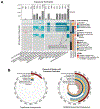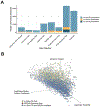The chemical landscape of high-throughput new approach methodologies for exposure
- PMID: 36435938
- PMCID: PMC9882966
- DOI: 10.1038/s41370-022-00496-9
The chemical landscape of high-throughput new approach methodologies for exposure
Abstract
The rapid characterization of risk to humans and ecosystems from exogenous chemicals requires information on both hazard and exposure. The U.S. Environmental Protection Agency's ToxCast program and the interagency Tox21 initiative have screened thousands of chemicals in various high-throughput (HT) assay systems for in vitro bioactivity. EPA's ExpoCast program is developing complementary HT methods for characterizing the human and ecological exposures necessary to interpret HT hazard data in a real-world risk context. These new approach methodologies (NAMs) for exposure include computational and analytical tools for characterizing multiple components of the complex pathways chemicals take from their source to human and ecological receptors. Here, we analyze the landscape of exposure NAMs developed in ExpoCast in the context of various chemical lists of scientific and regulatory interest, including the ToxCast and Tox21 libraries and the Toxic Substances Control Act (TSCA) inventory. We examine the landscape of traditional and exposure NAM data covering chemical use, emission, environmental fate, toxicokinetics, and ultimately external and internal exposure. We consider new chemical descriptors, machine learning models that draw inferences from existing data, high-throughput exposure models, statistical frameworks that integrate multiple model predictions, and non-targeted analytical screening methods that generate new HT monitoring information. We demonstrate that exposure NAMs drastically improve the coverage of the chemical landscape compared to traditional approaches and recommend a set of research activities to further expand the development of HT exposure data for application to risk characterization. Continuing to develop exposure NAMs to fill priority data gaps identified here will improve the availability and defensibility of risk-based metrics for use in chemical prioritization and screening. IMPACT: This analysis describes the current state of exposure assessment-based new approach methodologies across varied chemical landscapes and provides recommendations for filling key data gaps.
Keywords: Exposure Modeling, New Approach Methodologies (NAMs), Chemicals in Products, Biomonitoring, Empirical/Statistical Models.
© 2022. This is a U.S. Government work and not under copyright protection in the US; foreign copyright protection may apply.
Conflict of interest statement
COMPETING INTERESTS
The authors declare no competing interests.
Figures





References
-
- Muir DCG, Howard PH. Are there other persistent organic pollutants? A challenge for environmental chemists. Environ Sci Tech. 2006;40:7157–66. - PubMed
-
- Egeghy PP, Judson R, Gangwal S, Mosher S, Smith D, Vail J, et al. The exposure data landscape for manufactured chemicals. Sci Total Environ. 2012;414:159–66. - PubMed
-
- Kavlock R, Chandler K, Houck K, Hunter S, Judson R, Kleinstreuer N, et al. Update on EPA’s ToxCast program: providing high throughput decision support tools for chemical risk management. Chem Res Toxicol. 2012;25:1287–302. - PubMed
-
- National Research Council. Risk Assessment in the Federal Government: Managing the Process, 1983. - PubMed
Publication types
MeSH terms
Grants and funding
LinkOut - more resources
Full Text Sources
Research Materials

